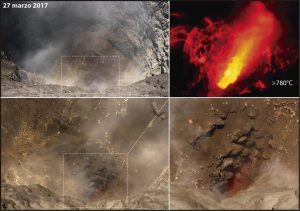
OVSICORI
Turrialba volcano temperatures are near 800 ° C. They are known as ‘magmatic’ temperatures and they refer to the existence of magma very near the surface.
These temperatures were verified by the Costa Rican Seismological and Volcanological Observatory (OVSICORI), using thermal cameras.
Maria Martínez, an OVSICORI chemistry, explained that these temperatures allow to observe incandescence from the bottom of the crater.
The volcano activity increased at the end of 2014. In recent months it has been very active, with periods of greater impact.
But… is it lava?
Lava is fresh magma expelled to the surface. It can be in the form of fine particles (juvenile ash) or in larger fragments of bombs.
These bombs fell near the crater due to its low eruptions, so many people interested in the volcano activity ignore their existence.
Turrialba eruptions are called estrombolians, and they consist of ejection of fresh lava bombs outside the crater.
According to Martinez, it is too early to say whether strombolian activity could continue for an extended period of time.